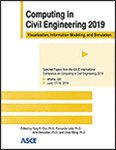ASCE International Conference on Computing in Civil Engineering 2019
The Relevance of Visual Cues in Immersive Environments: Does Pictorial Realism Matter?
Publication: Computing in Civil Engineering 2019: Visualization, Information Modeling, and Simulation
ABSTRACT
This paper aims at contributing to the debate on the extent to which cues of visual perception and pictorial realism in virtual reality (VR) environments are relevant in the context of construction practices. The discussion is conducted with the support of literature on human visual perception in physical and virtual environments. The article provides and develops on the argument that for various current VR applications in the construction industry VR environments may not need to resemble the physical world, especially in the design phase. Understanding the intricate relationship between our visual perception processes and information demands in the various construction activities could lead to the identification of visual aspects that are actually relevant for effective VR experiences. The discussion is merged into a summary on the power, limitations, and suitability of VR technology in building construction, followed by final considerations.
Get full access to this article
View all available purchase options and get full access to this chapter.
REFERENCES
Bertol, D. (1997). Designing Digital Space: An Architect's Guide To Virtual Reality. New York: John Wiley & Sons.
Chandrasegaran, S. K., Ramani, K., Sriram, R. D., Horváth, I., Bernard, A., Harik, R. F., and Gao, W. (2013). “The evolution, challenges, and future of knowledge representation in product design systems.” Computer Aided Design, 45(2), 204–228.
Cutting, J. E., and Vishton, P. M. (1995). Perceiving Layout and Knowing Distances: The Integration, Relative Potency, and Contextual Use of Different Information about Depth. Information Potency and Spatial Layout, 69–117.
Dunston, P. S., Arns, L. I., and Mcglothlin, J. D. (2011). “An immersive virtual reality mock-up for design review of hospital patient rooms.” Collaborative Design in Virtual Environments, Intellignet Systems, Control and Automation: Science and Engineering, 167–176.
Gibson, J. J. (1979). The Ecological Approach to Visual Perception. Boston: Houghton Mifflin.
Gifford, R. (2002). Environmental Psychology: Principles and Practice. Colville: Optimal Books. ISBN: 0968854303
Heydarian, A., Carneiro, J. P., Gerber, D., and Becerik-Gerber, B. (2015). “Immersive virtual environments, understanding the impact of design features and occupant choice upon lighting for building performance.” Building and Environment, 89, 217–228.
Hoffman, D. (1998). Visual Intelligence: How We Create What We See. New York: W. W. Norton.
Hoffman, D. D., and Singh, M. (2006). Vision: Form Perception. Nadel, Lynn (Ed.), Encyclopedia of Cognitive Science.
Interrante, V., Anderson, L., and Ries, B. (2006). “Distance perception in immersive virtual environments, revisited.” IEEE Virtual Reality Conference, 3–10.
Kim, M. J., Wang, X., Love, P. ED., Li, H., and Kang, SC. (2013). “Virtual reality for the built environment: a critical review of recent advances.” Journal of Information Technology in Construction (ITcon), 18, 279–304. ISSN: 1874-4753
Kosslyn, S. M. (1994). Image and Brain: The Resolution of the Imagery Debate. Cambridge: MIT Press. ISBN: 0-262-11184-5
Marr, D. (1982). Vision: A Computational Investigation into the Human Representation and Processing of Visual Information. New York: W. H. Freeman. ISBN: 0716715678
McGinn, C. (2004). Mindsight: Image, Dream, Meaning. Harvard University Press.
Paes, D., and Irizarry, J. (2016). “Virtual Reality Technology Applied in the Building Design Process: Considerations on Human Factors and Cognitive Processes.” Advances in Ergonomics in Design, 3–15.
Palmer, S. E. (2003). Visual Perception of Objects. Handbook of Psychology: Experimental Psychology, Three:7:177–211. John Wiley & Sons.
Renner, R. S., Velichkovsky, B. M., and Helmert, J. R. (2013). “The perception of egocentric distances in virtual environments – A review.” ACM Computing Surveys, 46(2), 40 pages.
Sacks, R., Perlman, A., and Barak, R. (2013). “Construction safety training using immersive virtual reality.” Construction Management and Economics, 31(9), 1005–1017.
Sinai, M. J., Krebs, W. K., Darken, R. P., Rowland, J. H., and McCarley, J. S. (1999). “Egocentric distance perception in a virtual environment using a perceptual matching task.” Human Factors and Ergonomics Society Annual Meeting, 43(22), 1256–1260.
Stanney, K. M., Mourant, R. R., and Kennedy, R. S. (1998). “Human factors issues in virtual environments: A review of the literature.” Presence, 7(4), 327–351.
Steuer, J. (1992). “Defining Virtual Reality: Dimensions Determining Telepresence.” Journal of Communication, 42(4), 73–93.
Thompson, W. B., Willemsen, P., Gooch, A. A., Creem-Regehr, S. H., Loomis, J. M., and Beall, A. C. (2004). “Does the quality of the computer graphics matter when judging distances in visually immersive environments?” Presence, 13(5), 560–571.
Witmer, B. G., and Singer, M. J. (1998). “Measuring Presence in Virtual Environments: A Presence Questionnaire.” Presence, 7(3), 225–240.
Information & Authors
Information
Published In
Computing in Civil Engineering 2019: Visualization, Information Modeling, and Simulation
Pages: 25 - 31
Editors: Yong K. Cho, Ph.D., Georgia Institute of Technology, Fernanda Leite, Ph.D., University of Texas at Austin, Amir Behzadan, Ph.D., Texas A&M University, and Chao Wang, Ph.D., Louisiana State University
ISBN (Online): 978-0-7844-8242-1
Copyright
© 2019 American Society of Civil Engineers.
History
Published online: Jun 13, 2019
Authors
Metrics & Citations
Metrics
Citations
Download citation
If you have the appropriate software installed, you can download article citation data to the citation manager of your choice. Simply select your manager software from the list below and click Download.
